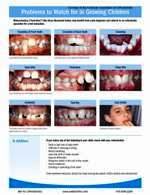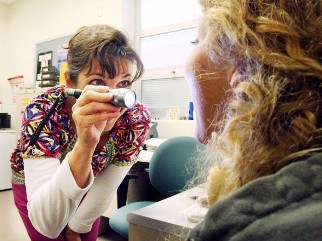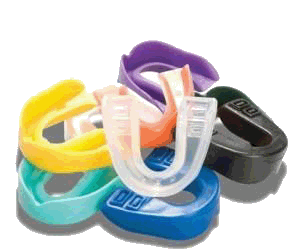October 7th, 2015
 Every October, the American Association of Orthodontists (AAO) takes the spotlight during National Orthodontic Health Month. It’s a time when orthodontists reach out to patients and their community to increase public awareness about the benefits of orthodontic care.
Every October, the American Association of Orthodontists (AAO) takes the spotlight during National Orthodontic Health Month. It’s a time when orthodontists reach out to patients and their community to increase public awareness about the benefits of orthodontic care.
As part of that effort, Bel Air Orthodontics is spreading the AAO’s message about the benefits of early orthodontic evaluation. Even though most people think of pre-teens and teens when they think of orthodontics, there are good reasons why all children should get an orthodontic evaluation much sooner. The American Association of Orthodontists recommends that every child get an orthodontic screening no later than age seven.
Why is age seven considered the optimal time for screening?
By this age, most children have a mix of baby teeth and adult teeth making it an ideal time for evaluation. With early screening, Dr. Godwin can spot subtle problems with emerging teeth and jaw growth. While many young patients may not be ready to start treatment, early evaluation allows us to choose the optimal time to begin treatment and provides a greater opportunity for an effective treatment outcome.
What are the potential advantages of interceptive treatment?
Early treatment allows Dr. Godwin to:
- Correct and guide the growth of your child’s jaw to help the permanent teeth come in straight
- Regulate the width of the upper and lower arches
- Create more space for crowded teeth
- Avoid the need for permanent tooth extractions later in life
- Correct thumb-sucking and help improve minor speech problems
Problems to Watch for in Growing Children
If you notice any of the following in your child, it’s time to schedule an orthodontic evaluation:
- Early/late loss of baby teeth
- Difficulty chewing or biting food
- Mouth breathing
- Finger or thumb sucking
- Crowded, misplaced, or blocked teeth
- Jaws that pop or make sounds when opening and closing
- Teeth that come together abnormally, or do not come together at all
- Jaws and teeth that are not proportionate to the rest of the face
- Crowded front teeth around age 7 or 8
Additional information on early interceptive treatment is available at the AAO’s website. To view and/or download their handout entitled “Problems to Watch for in Growing Children” click the image above.
Orthodontics does more than create beautiful smile – it creates a healthier you. If you have questions about your child’s dental development, contact our office at 410-838-2244 to schedule an evaluation.
September 17th, 2015
 It's back-to-school time, and that means the school nurses have their hands full. To make they're job a little easier, Bel Air Orthodontics recently visited schools throughout Harford County to make sure that nurses are prepared to handle orthodontic emergencies during the school day. Our complimentary kits provide school nurses with much needed dental supplies such as orthodontic wax, floss, toothbrushes and paste, along with a Nurse's Guide which is filled with helpful tips and emergency care information.
It's back-to-school time, and that means the school nurses have their hands full. To make they're job a little easier, Bel Air Orthodontics recently visited schools throughout Harford County to make sure that nurses are prepared to handle orthodontic emergencies during the school day. Our complimentary kits provide school nurses with much needed dental supplies such as orthodontic wax, floss, toothbrushes and paste, along with a Nurse's Guide which is filled with helpful tips and emergency care information.
With some minor intervention and guidance from the school nurse, many of our patients with minor emergencies such as broken brackets, loose and/or poking wires can return to class and finish out their school day. So if you're not sure how to handle an orthodontic emergency while at school, stop by the nurse's office. They've got the know-how and supplies to help you out thanks to the team at Bel Air Orthodontics.
Since some orthodontic emergencies may require repair by your orthodontist, Dr. Godwin also recommends that you contact our office as soon as possible so that we can address your concerns and/or schedule an appointment.
September 3rd, 2015
 Staying on track with your appointment scheduling is important to the success of your orthodontic treatment. Now that schools are back in session, Dr. Godwin would like to remind all of our patients about the importance of scheduling appointments in advance. With school, clubs, sports and family responsibilities to consider, we know that it can be challenging to find time to visit your orthodontist. After-school appointments are typically filled a month in advance, so remember to plan ahead and schedule your next appointment before leaving the office. While some orthodontic procedures have special time requirements that may conflict with work or school, we'll do our best to find an appointment time that is convenient for you. For more information on appointment scheduling, visit our website at www.belairortho.com/appointment-scheduling. As always, please remember to give us advance notice if you're unable to make your regularly-scheduled appointment. Early notification allows us to offer your reserved time slot to other patients and permits us to effectively accommodate everyone with busy schedules.
Staying on track with your appointment scheduling is important to the success of your orthodontic treatment. Now that schools are back in session, Dr. Godwin would like to remind all of our patients about the importance of scheduling appointments in advance. With school, clubs, sports and family responsibilities to consider, we know that it can be challenging to find time to visit your orthodontist. After-school appointments are typically filled a month in advance, so remember to plan ahead and schedule your next appointment before leaving the office. While some orthodontic procedures have special time requirements that may conflict with work or school, we'll do our best to find an appointment time that is convenient for you. For more information on appointment scheduling, visit our website at www.belairortho.com/appointment-scheduling. As always, please remember to give us advance notice if you're unable to make your regularly-scheduled appointment. Early notification allows us to offer your reserved time slot to other patients and permits us to effectively accommodate everyone with busy schedules.
Access Your Appointment Information 24/7
Did you know that patients at Bel Air Orthodontics have access to their appointment information 24 hours a day, seven days a week? From our website's Patient Portal, you can look up your appointments, access your account details, and establish email and/or text reminder preferences with a click of a mouse. If you haven't already signed up for this convenient service, contact our office today to set up your online account login.
We hope you enjoyed the lazy days of summer. Have a great school year!
August 26th, 2015
 With school and fall sports just around the corner, we thought it would be a great time to remind all our patients to protect their teeth and orthodontic appliances while out on the playing fields. According to the National Youth Sports Safety Foundation, school-aged athletes have more than 3 million teeth knocked out in youth sporting events annually.
With school and fall sports just around the corner, we thought it would be a great time to remind all our patients to protect their teeth and orthodontic appliances while out on the playing fields. According to the National Youth Sports Safety Foundation, school-aged athletes have more than 3 million teeth knocked out in youth sporting events annually.
So how do you protect your teeth? One of the most important pieces of sports equipment you can wear on the field is a mouthguard, especially when playing contact sports such as soccer, football and field hockey. Wearing a mouthguard can help kids with and without braces avoid serious sports injuries. In fact, the National Youth Sports Safety Foundation reported that athletes who don’t wear mouthguards are 60 times more likely to damage their teeth.
Whatever your sport, the right protective gear can save your face, your teeth, and your braces. If you or your child suffers dental trauma such as a knocked-out or broken tooth, Dr. Godwin suggest that you contact your dentist for immediate attention. For those in braces, it's also important to contact our office to schedule an appointment for repair since damage to braces can lengthen treatment time and affect treatment results.
If you're wearing braces, Dr. Godwin and the team at Bel Air Orthodontics are happy to supply you with a special orthodontic mouthguard. Feel free to ask us more about mouthguards and sports safety at your next visit. Have a great sports season!
 Every October, the American Association of Orthodontists (AAO) takes the spotlight during National Orthodontic Health Month. It’s a time when orthodontists reach out to patients and their community to increase public awareness about the benefits of orthodontic care.
Every October, the American Association of Orthodontists (AAO) takes the spotlight during National Orthodontic Health Month. It’s a time when orthodontists reach out to patients and their community to increase public awareness about the benefits of orthodontic care.



